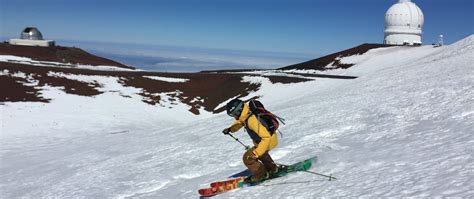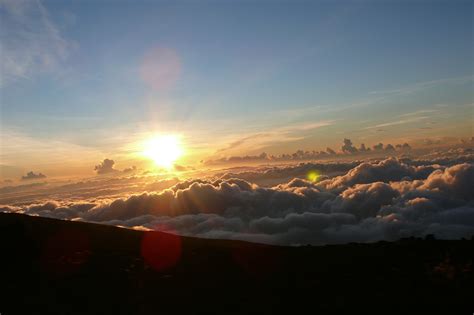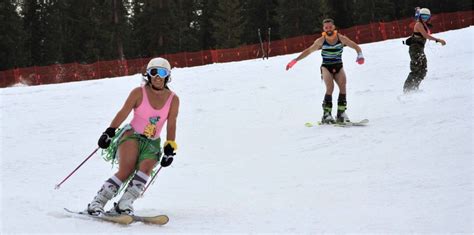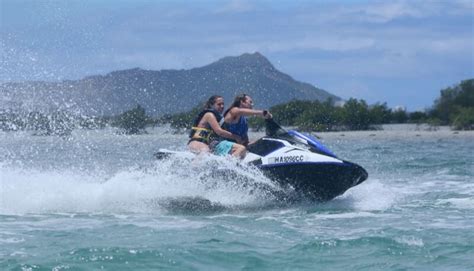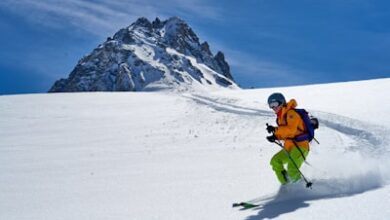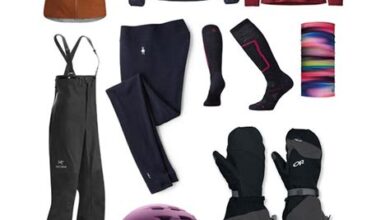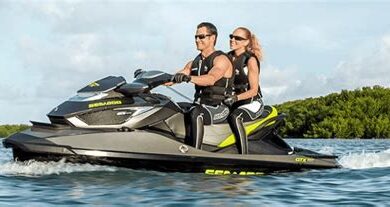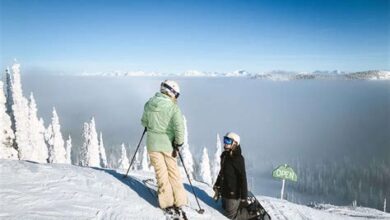Can You Ski In Hawaii?⏬
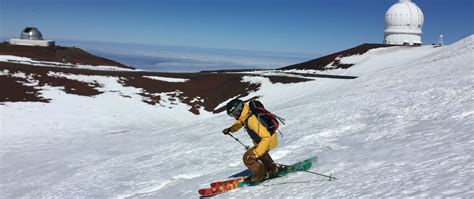
Explore the possibility of skiing on Hawaii’s volcanic slopes like Mauna Kea, Haleakala, and more. Discover unique ski adventures in Hawaii.Skiing might not be the first activity that comes to mind when you think of Hawaii, the land known for its lush tropical landscapes, idyllic beaches, and iconic surf waves. Yet, amidst this paradise, there are towering volcanic peaks that may just surprise winter sports enthusiasts in search of snow. Can you actually strap on your skis or snowboard in the Aloha State? In this blog post, we’ll explore the potential for alpine adventure on the Hawaiian Islands, from the lofty summits of Mauna Kea and Mauna Loa to the dormant volcano of Haleakalā, and beyond. We’ll uncover whether the islands of Maui, Oahu, and Kauai cater to this frostier form of fun. So, before you pack your skis and gloves along with your swimsuit and flip-flops, let’s take a closer look at Hawaii’s snowy offerings.
Can You Ski On Mauna Kea
Many adventure-seekers have pondered the question: Can you ski on Mauna Kea? Located on the Big Island of Hawaii, Mauna Kea stands as the tallest mountain in the state, reaching an astonishing 13,803 feet above sea level. Due to its significant elevation, during the winter months, it’s not uncommon for Mauna Kea’s summit to be draped with a blanket of snow, tantalizing the idea of skiing in Hawaii, a place better known for its sun-soaked beaches and tropical climate.
Remarkably, Mauna Kea does indeed offer the opportunity for skiing and snowboarding, but it is crucial to note that there are no established ski resorts, lifts, or ski patrols on the mountain. Those who seek to carve their way down its slopes must be prepared for a backcountry experience, as they are solely responsible for their own safety and must hike back up the mountain to enjoy multiple runs. Moreover, the quality of snow can be highly variable, and the weather conditions on the summit are often harsh and unpredictable.
The opportunity to ski on Mauna Kea is a unique experience that contrasts sharply with the traditional Hawaiian images of surfing and sunbathing. Due to the mountain’s sacred status in Hawaiian culture and its delicate ecosystem, skiers are urged to practice the utmost respect for the land and adhere strictly to the principles of ‘Leave No Trace’. For those not experienced in backcountry skiing or unfamiliar with the terrain, it is recommended to engage with local guides or tour operators who specialize in high-elevation, off-the-beaten-path excursions.
Weather permitting, the window for skiing on Mauna Kea is relatively short, typically spanning from December to February. Before attempting to ski, visitors should check for real-time weather updates and road closures, which can occur frequently during the winter. Here is a simple breakdown for those wondering about the feasibility of skiing on different Hawaiian mountains:
| Location | Possibility of Skiing | Remarks |
|---|---|---|
| Mauna Kea | Yes, with limitations | Backcountry skiing, no resorts or lifts |
| Mauna Loa | Rarely and difficult | Very rough terrain, less snowfall than Mauna Kea |
| Haleakala | Rarely and not recommended | Occasional snowfall, but skiing is not practical |
| Maui | No | No suitable areas for skiing |
| Oahu | No | Lacks the necessary elevation and conditions |
| Kauai | No | Mountainous but no snowfall |
With a spirit of adventure and proper preparation, Mauna Kea provides an exceptional, though non-traditional, skiing experience. It’s a rare chance to glide down the snowy slopes of a tropical paradise, surrounded by ocean views, and it affirms that Hawaii’s natural wonders extend far beyond its famed shorelines.
Can You Ski On Mauna Loa
Can You Ski on Mauna Loa is an intriguing question for avid skiers seeking a unique adventure; while Hawaii is renowned for its stunning beaches and surf breaks, Mauna Loa offers an unconventional skiing experience. Notably, Mauna Loa is one of the few spots within the Hawaiian archipelago where one might envision skiing due to its high elevation and occasional snowcap during the winter months.
It is crucial to emphasize that skiing on Mauna Loa is not akin to resort skiing; there are no ski lifts, groomed runs, or on-site amenities. Adventurous skiers must be prepared to trek with their gear to the slopes. Moreover, only those with advanced backcountry skiing skills should even consider this endeavor, as the terrain can be unpredictable and, at times, perilous.
Below is a comparison of the feasibility of skiing in various locations across Hawaii:
- Mauna Kea: Better suited for skiing when conditions permit, with occasional snowfall providing a more reliable base.
- Haleakalā: Rarely sees snow, making skiing opportunities extremely limited and irregular.
- Oahu and Kauai: These islands are not known for skiing, having no suitable elevations or conditions for the sport.
A summary table illustrating the skiing prospects on Hawaiian peaks:
| Location | Elevation | Snowfall | Skiing Possibility |
|---|---|---|---|
| Mauna Loa | 13,678 ft | Seasonal | Potentially, for backcountry experts |
| Mauna Kea | 13,803 ft | More Regular | More likely than on Mauna Loa |
| Haleakalā | 10,023 ft | Sporadic | Rare and inconsistent |
| Maui, Oahu, and Kauai | Various | None to very rare | Not suitable |
In conclusion, skiing on Mauna Loa remains a possibility for the exceedingly skilled and daring skier, yet one should be thoroughly prepared for the risks and challenges inherent in such an atypical skiing adventure.
Can You Ski On Haleakala
When considering a snowy adventure on the tropical islands of Hawaii, skiing may not be the first activity that comes to mind, but surprisingly it’s a query worth exploring. Specifically, the concept of skiing on Haleakala, a massive shield volcano that forms more than 75% of the Hawaiian Island of Maui, raises eyebrows and curiosity alike. This majestic peak, standing at over 10,000 feet, occasionally experiences a dusting of snow, leading to the question: Can You Ski On Haleakala?
Firstly, it is paramount to understand that Haleakala is not equipped with ski lifts or groomed slopes as one would find in traditional ski resorts. Instead, the possibility of skiing here entirely depends on Mother Nature’s whims. Snowfall on Haleakala tends to be an infrequent and unpredictable event, usually occurring during the colder months at the volcano’s summit. Those who wish to embark on this rare skiing expedition must be self-sufficient and experienced in backcountry skiing.
Furthermore, potential skiers should be cautious and fully prepared, as the terrain is rugged and the weather conditions can be harsh and rapidly changing. Interested adventurers must be ready to hike with their equipment to the top, as there are no ski lifts available. Here is what you should consider if you are determined to pursue this unique skiing experience:
- Check the weather forecast rigorously before planning your trip, as snow can be fleeting on Haleakala.
- Prepare for backcountry conditions; this includes having the appropriate gear and safety knowledge for both skiing and mountaineering.
- Be aware that the National Park Service does not offer rescue services for skiing-related accidents, so ski at your own risk.
- The ecological sensitivity of the area means respecting the land and understanding the cultural significance of Haleakala to the Native Hawaiian people.
For those still dreaming of carving turns on this Polynesian paradise, below is a table that provides a quick glance at what skiing on Haleakala entails:
| Consideration | Detail |
|---|---|
| Altitude | Over 10,000 feet (3,050 meters) |
| Snow Conditions | Unpredictable and intermittent |
| Accessibility | No ski lifts; hiking required |
| Safety | Backcountry dangers with no rescue services |
| Environmental Impact | High importance to respect and maintain the natural habitat |
In conclusion, while there is potential for skiing on Haleakala, it remains a rare and highly conditional pursuit. Those with a passion for both skiing and adventure who are willing to navigate the challenges may find themselves rewarded with the unique bragging rights of skiing on one of the most scenic volcanoes of Hawaii. However, caution and preparation are vital, as the experience vastly differs from resort skiing and is recommended only for those who are highly skilled and knowledgeable about wilderness survival.
Can You Ski On Maui
Maui, known for its lush beaches and tropical climate, may not be the first place that comes to mind when considering a skiing destination. However, the question arises: Can you ski on Maui? It’s an intriguing possibility for those who dream of carving turns on the slopes with a view of the Pacific Ocean.
To be clear, Maui does not have traditional ski resorts, nor does it boast the alpine conditions typically associated with the sport. Thus, one cannot expect to find groomed pistes or chairlifts. The island’s geography simply does not support the infrastructure and climate necessary for conventional skiing. However, during exceptionally rare conditions, the summit of Haleakalā, Maui’s tallest peak, might receive a dusting of snow due to its high elevation.
In such cases, a bold adventurer could theoretically make a few turns on the frosty flanks. Skiing on Haleakalā, or any other peak, would undoubtedly be a backcountry experience, requiring hikers to ascend on foot and ski down at their own risk. It is crucial to note that these events are sporadic, and any attempt to ski on Maui should be approached with caution and respect for the delicate island ecosystems.
If you’re still holding out hope for some form of skiing on Maui, you might consider water skiing or jet skiing as exhilarating alternatives. These water-based activities are widely available and provide a completely different set of thrills amidst the island’s beautiful coastal settings.
In summary, while Maui does not offer traditional snow skiing, it holds a multitude of other adventure opportunities. Always make sure to do your research, prepare adequately, and ensure that any activities you indulge in are safe and environmentally conscious.
Can You Ski On Oahu
When most people think of Oahu, the image that springs to mind is usually sun-soaked beaches and surfers riding the waves, not snowy slopes and skiers carving down the mountainside. However, there is often curiosity around the possibility of experiencing a unique tropical ski adventure on the island. Despite its tropical reputation, it’s an intriguing question to ask: Can you ski on Oahu?
To answer this query, one must first consider the geography and climate of Oahu. As it stands, Oahu is home to a lush landscape and a warm, tropical climate year-round. The island lacks the elevation required for winter sports, and it does not receive snowfall. Therefore, traditional alpine skiing and snowboarding as one might imagine are not feasible activities on Oahu.
However, for those who are drawn to the idea of skiing in Hawaii, water skiing and jet skiing offer thrilling alternatives. These water sports are quite popular on the island, providing a unique blend of high-speed excitement with the scenic beauty of the Pacific Ocean as your backdrop. Whether you’re a beginner or an expert, you can find opportunities for water skiing in areas like Maunalua Bay and Waikiki, where the water is clear, and the weather is almost always perfect for such sports.
In summary, while Oahu does not offer traditional snowy slopes for skiing, it presents a delightful playground for water-based skiing enthusiasts. Those wishing to experience the joy of skiing can certainly indulge in the aquatic version, which aptly captures the spirit of adventure found on the island. Oahu’s breathtaking natural beauty and warm waters provide an exceptional setting for water skiing, turning the absence of snow into an opportunity for another kind of exhilarating experience.
Can You Ski On Kauai
When one thinks of Kauai, the envisioning of lush tropical rainforests and stunning beaches often comes to mind. However, the prospect of skiing in such a paradisiacal landscape seems almost contradictory. Kauai, also known as the Garden Isle, is the fourth largest island in the Hawaiian archipelago and is celebrated for its diverse ecosystems and breathtaking geology, not for alpine environments typically associated with winter sports.
Despite its tropical climate, Kauai’s Mount Wai’ale’ale is one of the wettest spots on Earth, raising the question among winter sport enthusiasts: Can one actually ski on Kauai? Unfortunately, the reality is that Kauai does not offer traditional skiing opportunities as you would find in colder climates with snow-capped mountains. The island lacks the snow and infrastructure such as ski lifts, slopes, or resorts that cater to this type of activity.
For those determined to find a snow skiing experience in Hawaii, the options are incredibly limited and usually involve visiting the Big Island during those rare instances when snow blankets the summits of its tallest volcanoes, Mauna Loa and Mauna Kea. It is only here, in the presence of enough snowfall, that one might attempt to ski or snowboard. However, this is nothing like structured ski experiences on the mainland, as there are no proper amenities or rescue services, and the risk is entirely on the adventurer.
Yet, adventure seekers might want to consider alternative types of ‘skiing’ when in Kauai. For instance, water skiing and wakeboarding are sports that can be enjoyed on the warm waters surrounding the island. To illustrate the alternative adventurous activities available in Kauai, let us create a table of options:
| Activity | Description | Location |
|---|---|---|
| Water Skiing | An exhilarating water surface sport involving being pulled behind a boat while riding on skis. | Kauai’s navigable waters, such as the Wailua River or off the island’s coast. |
| Wakeboarding | Similar to water skiing, but with a single board akin to a snowboard.This sport offers a thrilling experience as one is towed behind a boat. | Popular in the ocean waters, as well as on the island’s rivers, like the Hanalei River. |
| Mountain Tubing | A unique Kauai activity where one floats down old sugar plantation irrigation channels and tunnels. | The channels wind through some of the island’s most beautiful and remote land on Kauai. |
In conclusion, while Kauai may not be a destination for traditional skiing pursuits, the island’s natural beauty and warm climate offer a host of other thrilling leisure activities. Instead of seeking snow-covered slopes, visitors can embrace Kauai’s unique tropical adventure offerings, ensuring an unforgettable experience in one of Hawaii’s most treasured islands.
Frequently Asked Questions
Is it possible to ski in Hawaii?
Yes, it is possible to ski in Hawaii, particularly on Mauna Kea on the Big Island where snowfall is seasonal, mostly during the winter months.
What is Mauna Kea and why is it suitable for skiing?
Mauna Kea is a dormant volcano on the Big Island of Hawaii. It’s the highest point in the state, with its summit reaching 13,796 feet above sea level, where snow can accumulate in winter, making it suitable for skiing.
Are there any ski resorts in Hawaii?
Hawaii does not have traditional ski resorts with lifts and groomed slopes like you would find on the mainland. Skiing on Mauna Kea is a backcountry experience, typically for advanced skiers.
Do you need special equipment to ski in Hawaii?
Yes, due to the backcountry nature of skiing in Hawaii, you should have appropriate equipment for off-piste skiing, including all-terrain skis, and be prepared for variable snow conditions.
When is the best time to plan a ski trip to Hawaii?
The best time for skiing in Hawaii is typically from January to March when there’s a greater chance of snowfall on the higher elevations of Mauna Kea.
Are there any guided ski tours available in Hawaii?
While not common, some adventure tour operators may offer guided ski experiences on Mauna Kea. It’s crucial to check for availability and to ensure that guides are experienced with the local terrain and conditions.
What are some safety considerations when skiing in Hawaii?
Skiers need to be aware of the risks associated with high altitudes, rapidly changing weather conditions, and the lack of ski patrol or rescue services on the mountain. Preparing for self-rescue and having proper safety gear is essential.

